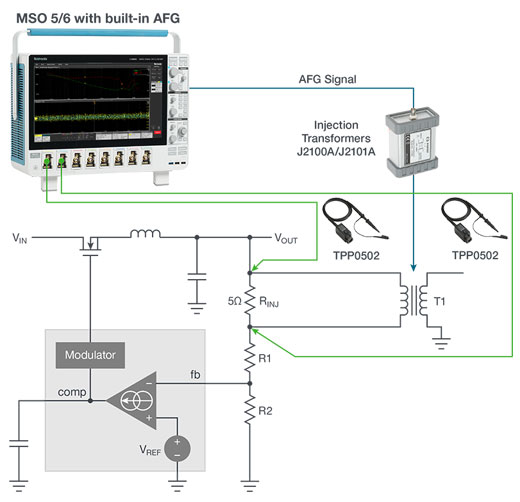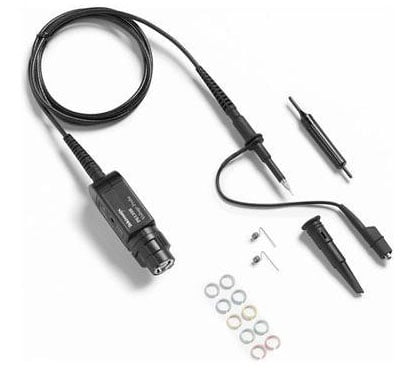Contact us
Call us at
Available 6:00 AM – 5:00 PM (PST) Business Days
Download
Download Manuals, Datasheets, Software and more:
Feedback
Control Loop Analysis
Oscilloscope-based response measurement setup

For power supply designs, closed loop response measurements should be made from near DC to a few MHz. While vector network analyzers are often used for response analysis, most VNAs are designed for RF measurements with starting frequencies around a megahertz. In contrast, oscilloscopes can measure down to DC and provide useful signal visibility. If anomalies turn up during your analysis, you can quickly jump into troubleshooting.
Several Tektronix oscilloscopes offer built-in signal sources that may be used to inject a signal into the loop’s feedback through an isolation transformer. Two probes, applied across a low-value injection resistor, provide all the information the analysis software needs. It measures the stimulus and response amplitudes to calculate gain, and measures the phase delay between stimulus and response.
The general system for automated control loop response consists of:
- An oscilloscope with appropriate bandwidth
- Power supply frequency response automation software
- Two low-attenuation, low-capacitance probes
- A sinewave generator
- A transformer with flat response to isolate the sinewave generator from the DUT
Probe characteristics for control loop measurements
To avoid overdriving the control loop, the injection signal's amplitude must be kept low. Probe attenuation should be minimized to get the best sensitivity. At the same time, probe loading effects should be minimized. Durable, low-attenuation, low capacitance passive probes such as the TPP0502 are well-suited for these measurements with 2X attenuation, and 2 MΩ, 13 pF loading.

Measuring stability margins with Bode plots

Fast demand changes introduce high frequencies into power supply control loops. Supplies must respond quickly but adding too much gain will cause ringing or oscillation.
Instability occurs when the loop has positive gain (≥ 1) as phase shift approaches -180°. Under these conditions the loop will experience positive feedback and become unstable. Bode plots show gain and phase on the same frequency scale and let you see how close you are to this undesirable situation. Two measurements taken from a Bode plot gauge the safety margin in the control loop: phase margin and gain margin.
Phase margin indicates how far the system is from instability (-180° and unity gain) in terms of degrees of phase. It represents the amount of phase shift the loop can tolerate as the gain approaches 0 dB (unity gain).
Gain margin is how far the system is from -180° and unity gain in terms of dB of gain. This is the amount of gain that could be added before hitting 0 dB, when phase shift = -180°.
Maintaining ample phase and gain margin in the control loop ensures that a power supply will not operate too close to instability.
Download the application note on Bode Plots and Control Loop Response Measurements
Control loop analysis system
An oscilloscope-based system provides more versatility than dedicated network analyzers. A system includes:
- An oscilloscope with frequency response analysis software
- A function generator
- Probes and cables
- Injection transformer for Bode plots
- Line injector for PSRR measurements
The 4, 5 and 6 Series MSO oscilloscopes offer an Advanced Power Analysis option (PWR) and an optional built-in function generator. Picotest injection transformers (J2100A or J2101A) and line injectors (J2120A) are recommended for Bode plots and PSRR measurements.



